This apple babka features a filling of apples cooked in honey and boiled apple cider for a burst of rich apple flavor, and the apple cinnamon glaze is the perfect finish. Apple honey babka is what to serve for an Autumn breakfast, brunch, or after your festive Rosh Hashanah (Jewish New Year) meal!

Jump to:
[August, 2023: I've reworked the recipe and updated this post with all new pictures. Enjoy!]
Why this recipe works
- Tender honey-sweetened brioche-type bread
- Bursting with apple flavor from boiled cider in both the filling and the glaze
- Clear step by step instructions for shaping babka
Many types of breads and rolls are based on brioche, a bread enriched with eggs, milk, and butter. Challah is an egg-enriched bread which can be braided and shaped in so many different ways. Cream buns are lightly sweetened and glazed brioche-style rolls filled with clouds of whipped cream and a dusting of powdered sugar.
Babka is bread that falls in between challah and brioche - it’s egg and butter enriched, but not so much as to overpower the filling. Babka is also shaped (like a challah), but instead of braiding, it has a filling rolled up into it (similar to a cinnamon roll).
The upshot is when you slice into a babka, you see the veins of filling swirling about, complemented by the bread itself.
A baked apple honey babka is incredibly tasty - think apple pie filling stuffed into challah. You an also slice it thickly and use it for an apple french toast. Babka also is great in a baked french toast casserole. Delicious!
Unlike an apple cinnamon babka, there is intense apple flavor in this apple honey babka from the boiled cider that's not overly spicy, just sweet. Yummm...
Once you bake an apple honey babka, you can make other varieties like a Chocolate Babka with a fudge filling or maybe a Cranberry Cinnamon Babka for Thanksgiving or Christmas. Use your imagination!
And for those celebrating Rosh Hashanah, I wish you a sweet and prosperous New Year!
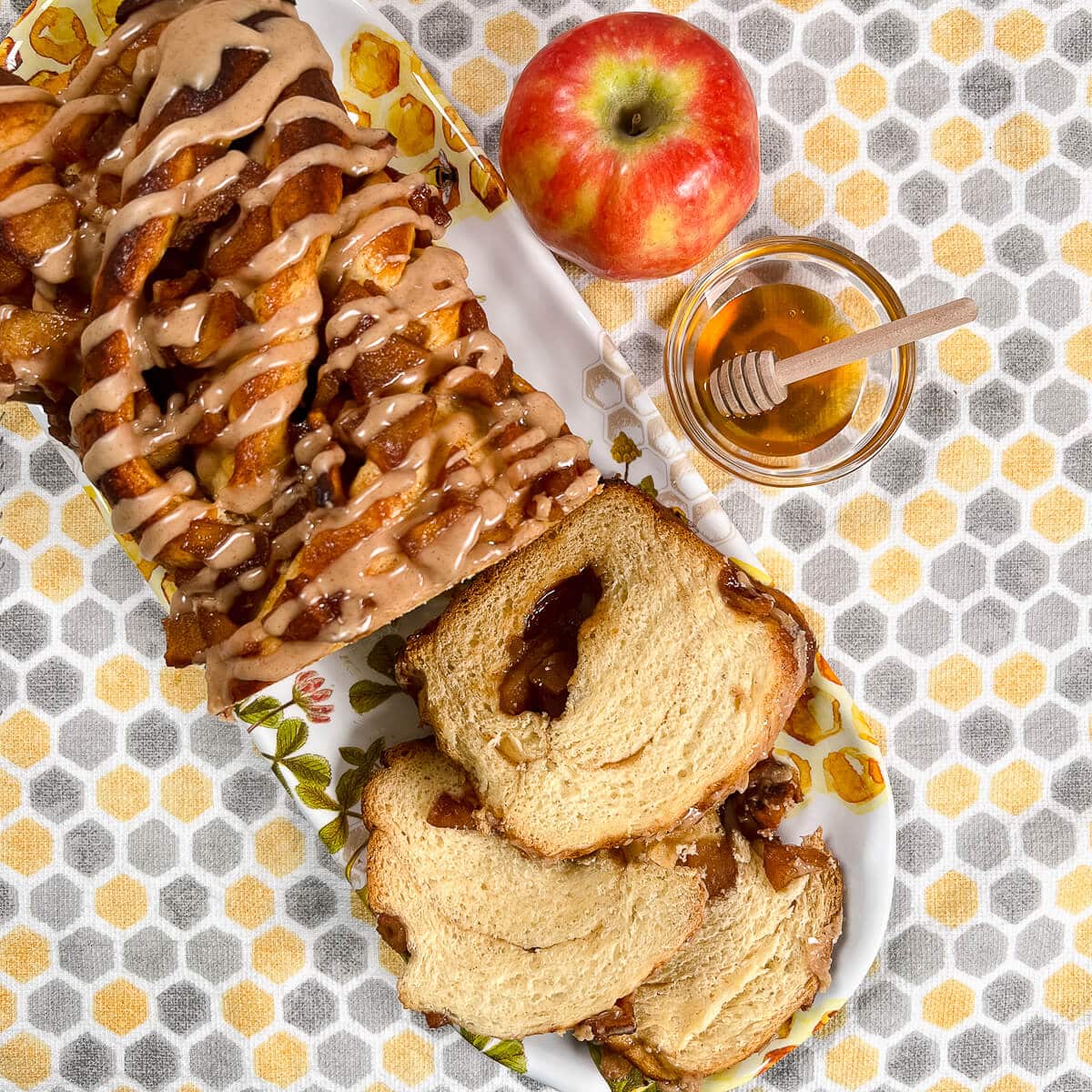
Apples and honey as symbols
Apples and honey feature prominently in celebrating Rosh Hashanah, the Jewish New Year. Traditionally, apples are dipped in honey to represent the wish to have a sweet year.
Desserts that feature apples or honey figure prominently as well. Honey Cake is another traditional dessert served after the celebratory meal, and Honey Cookies make a delightful snack.
Another delicious example is an Apple Galette in Phyllo Dough. And believe it or not, Sticky Toffee Apple Pudding (or it's original cousin, Sticky Toffee Pudding) can also be served on Rosh Hashanah - with all that sweetness, it's bound to be a sweet year!
Recipe Ingredients
You'll need the following ingredients to make this Apple Honey Babka recipe:

Ingredient Notes
Apples: Apples are available year-round, but for Autumn baking, apples are prominent. What type of apples are best in babka? For this apple babka recipe, try to find apples that will hold their shape while baking. Several examples include Granny Smith (a classic, but a bit tart in this application, if you ask me), Paula Reds (crisp and sweet, and won’t discolor after being cut), or Jazz (these work quite well). Other suggestions would be Pink Lady, Jonagold, or Golden Delicious. Feel free to combine apple varieties as well.
Boiled Apple Cider: The filling and glaze for this apple babka recipe features boiled apple cider to really boost the apple flavor. What is boiled cider? Think of it as the apple equivalent of maple syrup. Apple cider is boiled down until it's got the same consistency as honey. It's easy to make, or you can find ready-made boiled cider. In a pinch, you can use thawed apple juice concentrate, but it will be more liquidy and less flavorful than the boiled cider.
Honey: Use your favorite type of honey - its subtle floral notes are there to add an undertone to the flavor of the apple filling, but likely won't be noticeable in the babka bread itself.
Milk and Butter: The difference between making a babka dough and challah dough is the use of butter and milk instead of canola oil and water. Butter is used to add richness and flavor, and milk gives the dough a softer texture.
Yeast: I use instant yeast in all my baking, but Active Dry yeast can also be used (see the FAQ's below for the difference between the types of yeast).
See recipe card for a full list of ingredients and measurements.
How to peel and slice apples
Peeling and slicing the apples can be a chore, but it does't have to be. If you have an apple peeler/corer/slicer, you can prep the apples in a single step. Plus, apple spirals are fun! You only have to slice the spiral into pieces, and you're done.

Otherwise, a serrated peeler will make quick work of peeling the apples, and a melon baller is a good way to scoop out the core. Using a mandolin slicer speeds up the slicing and insures uniform pieces. Just be careful with the sharp blade, and make sure you use the food guard! I definitely use the food guard on the mandolin - I want to keep all my fingers!

How to make apple honey babka
While the recipe might seems long, there really are only 4 main steps to making a babka recipe: make the babka bread dough, make the filling, assemble and bake the babka, then glaze the baked loaf. I've broken down the steps and have included a lot of pictures, so don't panic. I've got you!
Step 1: Prepare the dough
Heat the milk until it’s warm to the touch, about 100 °F to 110 °F as read on a digital thermometer (photo 1). If the milk is too warm, you'll kill the yeast.

Stir in the sugar, then sprinkle the yeast over the milk and set aside to proof for about 5 minutes or until bubbles form on the surface of the milk (photo 2).
This step is called "proving the yeast." Letting it foam "proves" the yeast is active and ready to go to work, and it's especially useful if you use Active Dry yeast rather than instant yeast.

Pour the milk into the bowl of a stand mixer fitted with the paddle attachment. Add the egg, honey, and vanilla, then mix on low speed for about 30 seconds. Add the flour and the salt and mix on low speed until a sticky dough forms (photo 3).

Add the butter, 1 tablespoon at a time, and mix in thoroughly before adding in another tablespoon.
When all the butter is incorporated, switch to the dough hook and knead the dough on medium speed until a smooth and slightly sticky dough forms, about 5 to 10 minutes (photo 4). Add more flour in 1 tablespoon increments as needed to make the dough the right consistency.
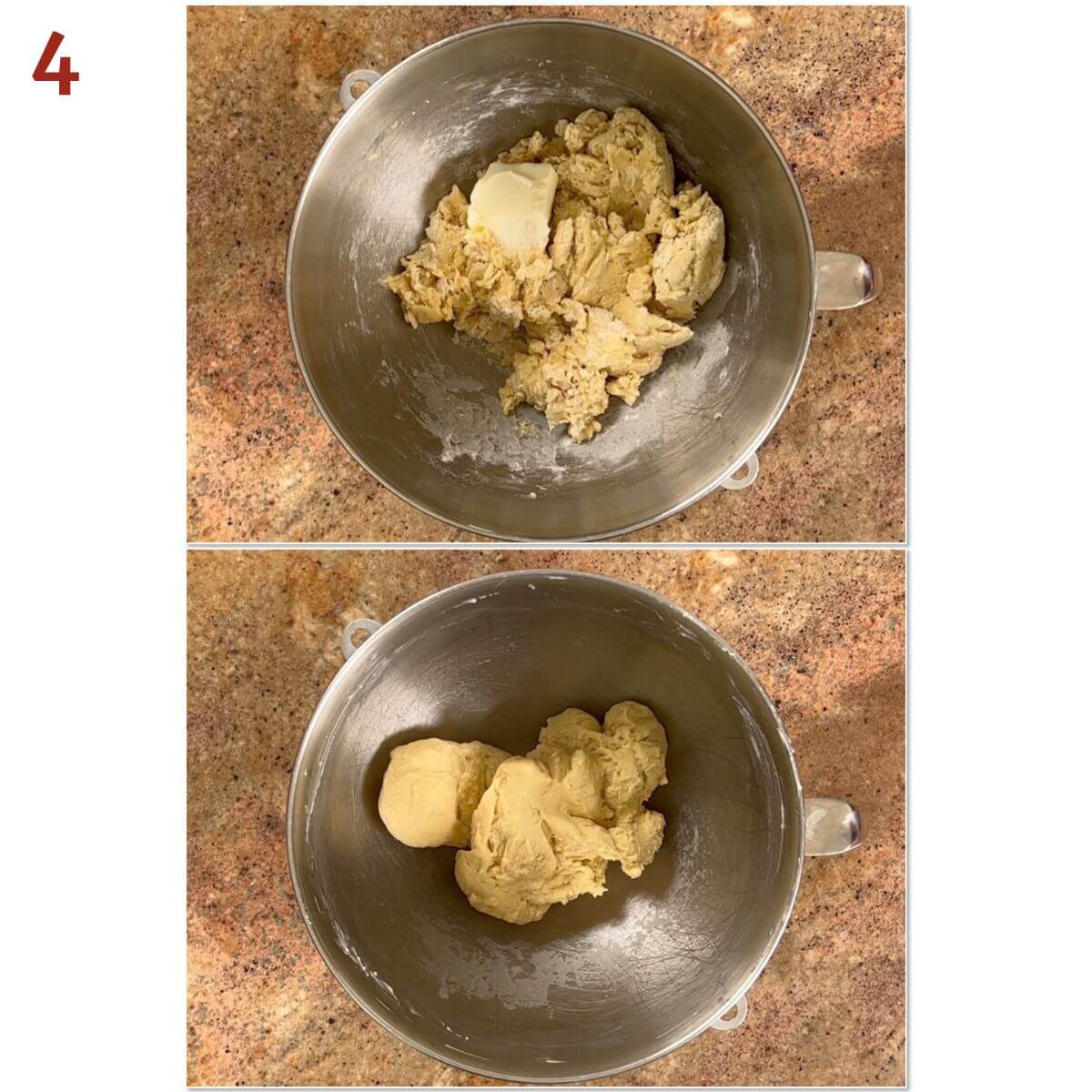
Spray a 2-quart dough rising bucket or a large bowl with canola oil spray and place the dough ball in smooth side down to wipe it with oil. Turn the dough with the gathered rough part of the dough down and the smooth surface of the ball facing up.
Cover with the lid or plastic wrap and let it rise in a warm place for about 1 hour, or until the dough has doubled in size (photo 5). The inside of an unheated oven with the light on works well.

Step 2: Make the apple filling
Peel and core the apples, then slice the apples thinly, about ⅛-inch thick. See below for ideas for the best way to do this step. Cut the sliced apples into small pieces.
Melt the butter in a large skillet over medium-high heat. Cook the apples, stirring occasionally, until they start to soften, about 5 to 10 minutes depending on the thickness of the slices. Add honey, boiled apple cider, and cinnamon (photo 6).
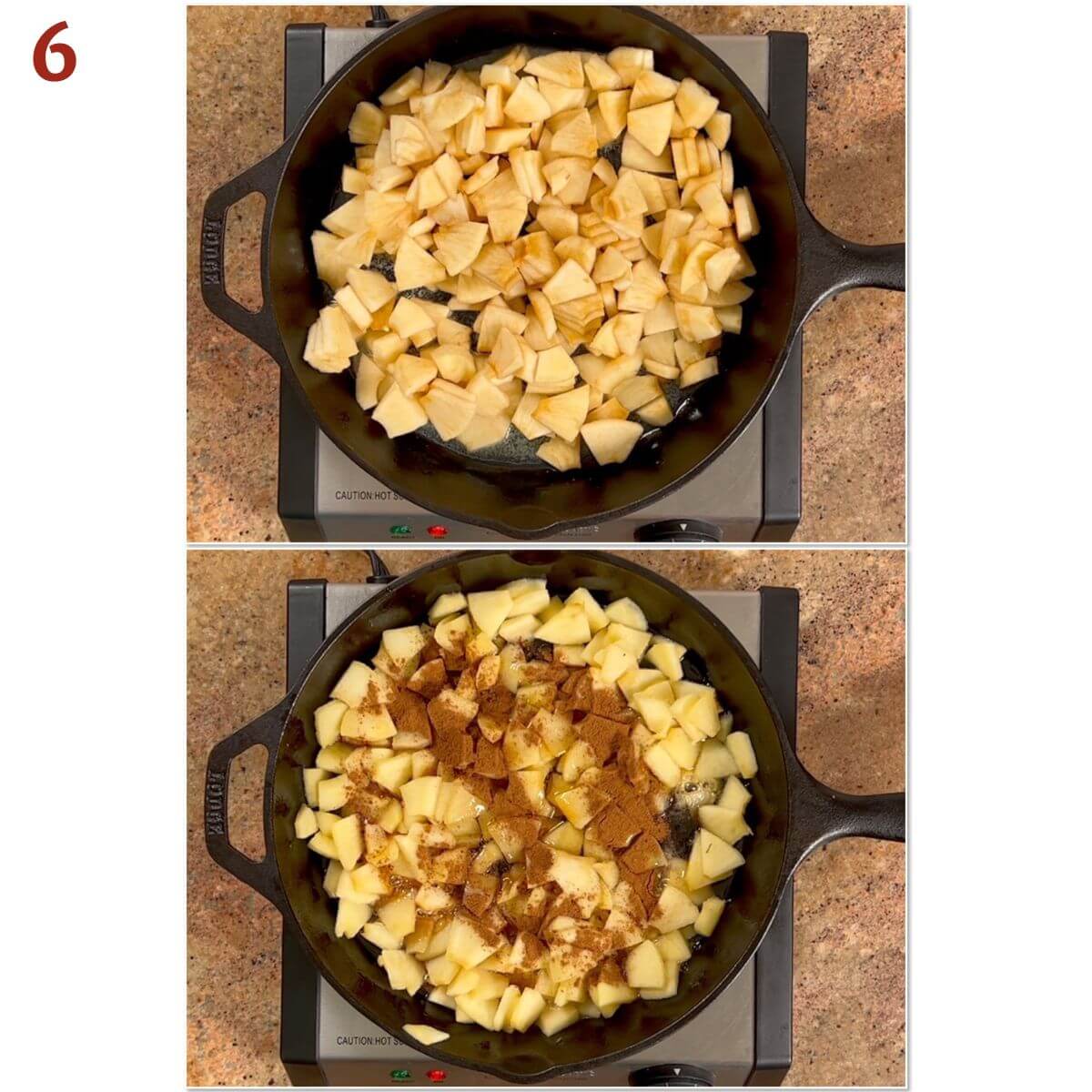
Reduce the heat and simmer until the sauce has thickened, about 8 to 10 minutes (photo 7). Transfer to a bowl and allow the apples to cool to room temperature, about 30 minutes.
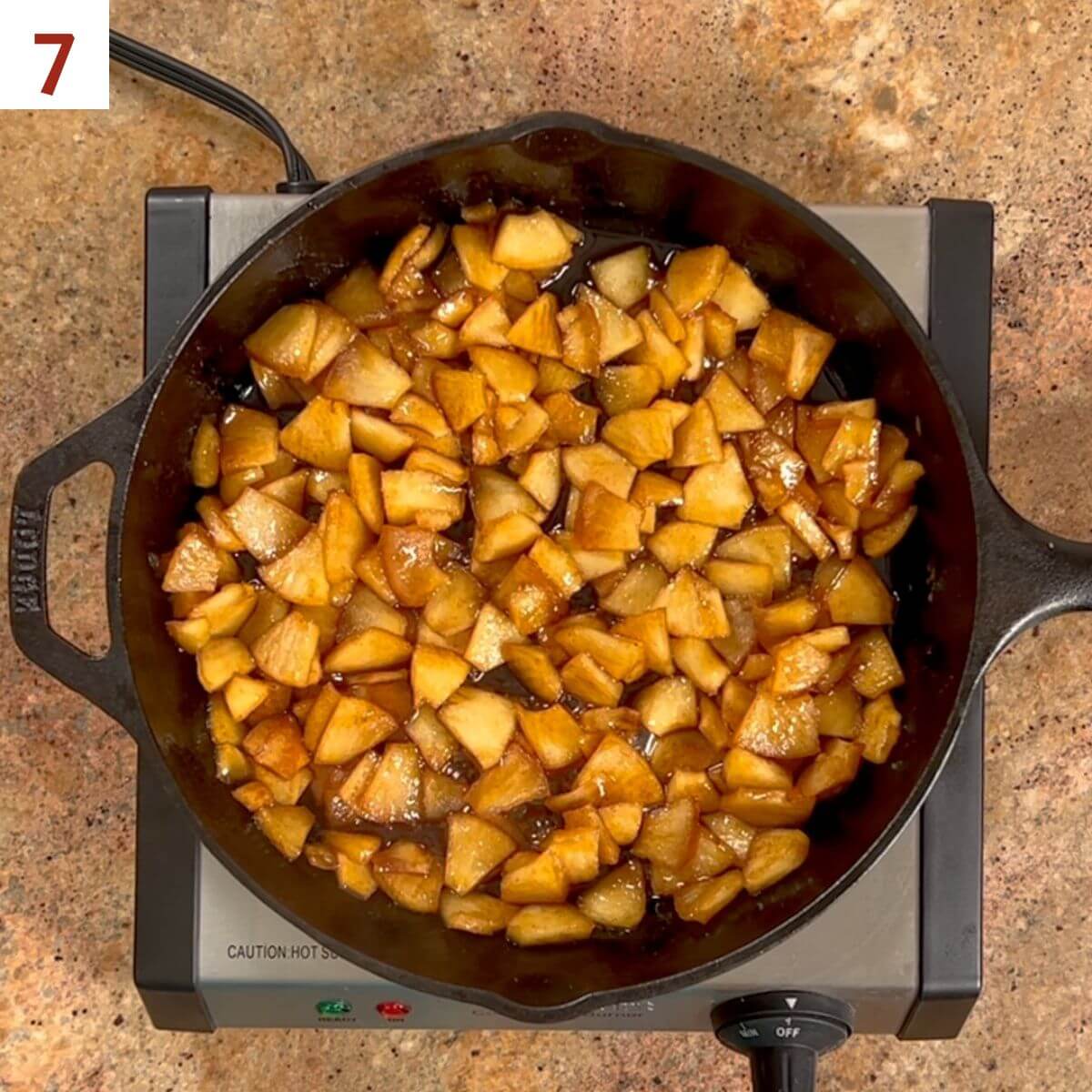
Step 3: Assemble the babka
Spray a standard loaf pan with baking spray and line with parchment paper, leaving a 2-inch overhand on the long sides. Set aside.
Dust a clean surface with flour and roll the dough out to a rectangle roughly 10- x 14-inches, about ¼-inch thick, with a long side facing you, in landscape orientation (photo 8).
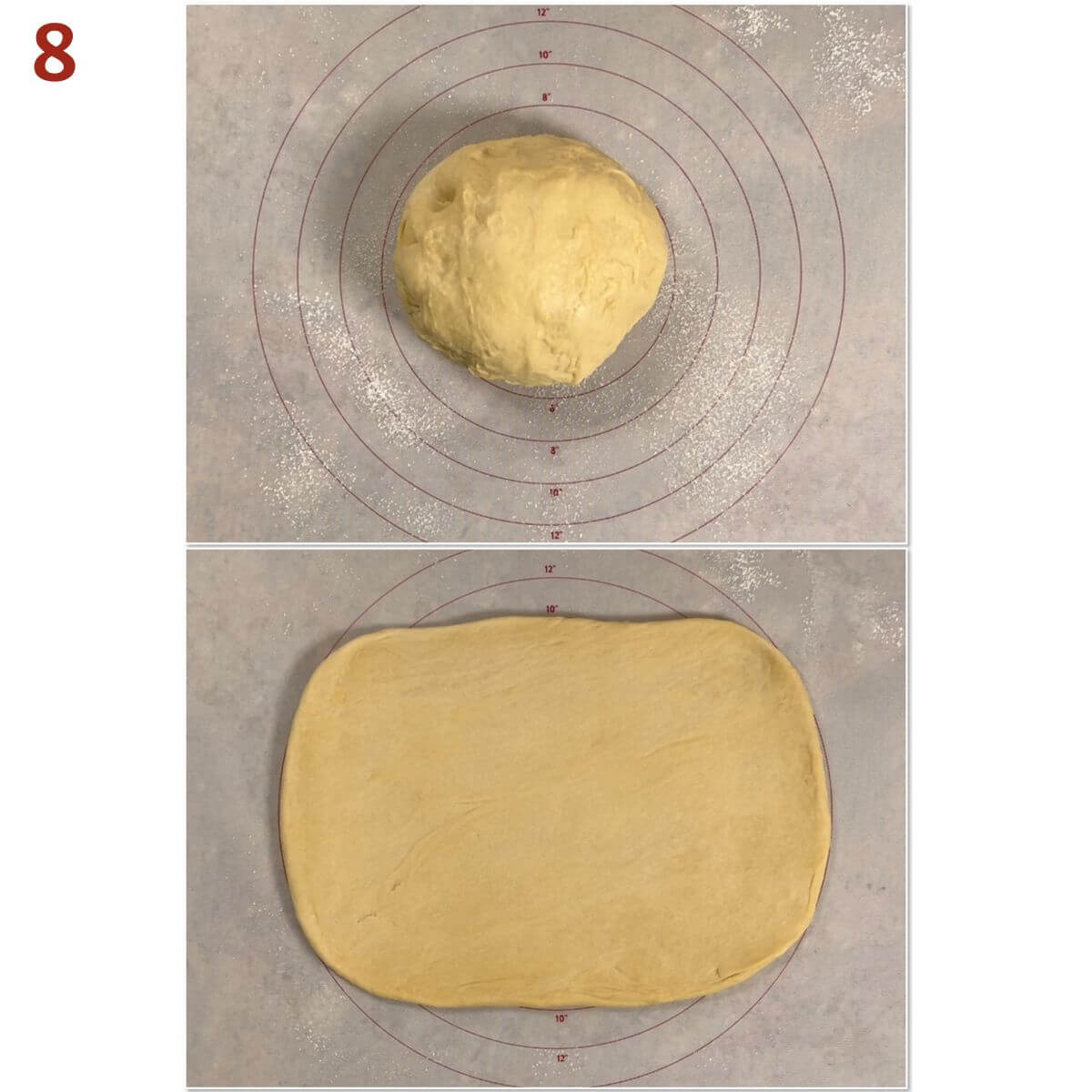
Using a large offset spatula, spread the cooled apples over the surface of the dough, leaving a 1-inch strip bare along the long side away from you.
Tightly roll the dough up from the long side facing you, making a 14-inch rope (photo 9).
Dust a clean surface with flour and roll the dough out to a rectangle roughly 10- x 14-inches, about ¼-inch thick, with a long side facing you, in landscape orientation (photo 9). Try to catch as much of the filling as possible as you roll so it will be evenly distributed in the babka.

Slice the rope in half lengthwise using a bench scraper making two 14-inch long pieces. If you want, you can twist each long piece individually so the apples are trapped inside the dough, tucking in any apples that may have fallen out.
Wrap the two lengths of dough together into a rope (photo 10).

Squish the twisted dough together and transfer it to the prepared loaf pan, tucking in any stray pieces of apples and dough. This is messy business but worth it in the end!
Cover the pan with a shower cap or a piece of greased plastic wrap and let the dough rest for 30 minutes (photo 11). While the babka loaf is resting, preheat the oven to 350°F.

Step 4: Bake the babka
Whisk together the beaten egg with the water to make an egg wash. Once the dough has rested (it won’t have risen much, just a tiny bit), brush the egg wash over the top of the dough with a pastry brush.
[Side Note: If you’d rather not make the apple glaze, you can just sprinkle some course sugar on the egg-washed babka before putting it in the oven to add sweetness and crunch (but really…no glaze?).]
Place the loaf pan on a quarter sheet baking pan (to catch any drips) and bake for 45 minutes. Cover the top with foil after about 30 minutes if it's getting too dark.
Reduce the oven temperature to 325°F and continue to bake until the top of the babka is deep brown, about 15 minutes more, and the loaf sounds hollow when tapped on the top. The babka will be fully baked when the center reads at least 190°F (photo 12).
Let babka cool in the pan for 15 minutes on a wire cooling rack, then use the parchment paper to lift the babka out of the pan and transfer it to back to the wire cooling rack. Let cool completely.
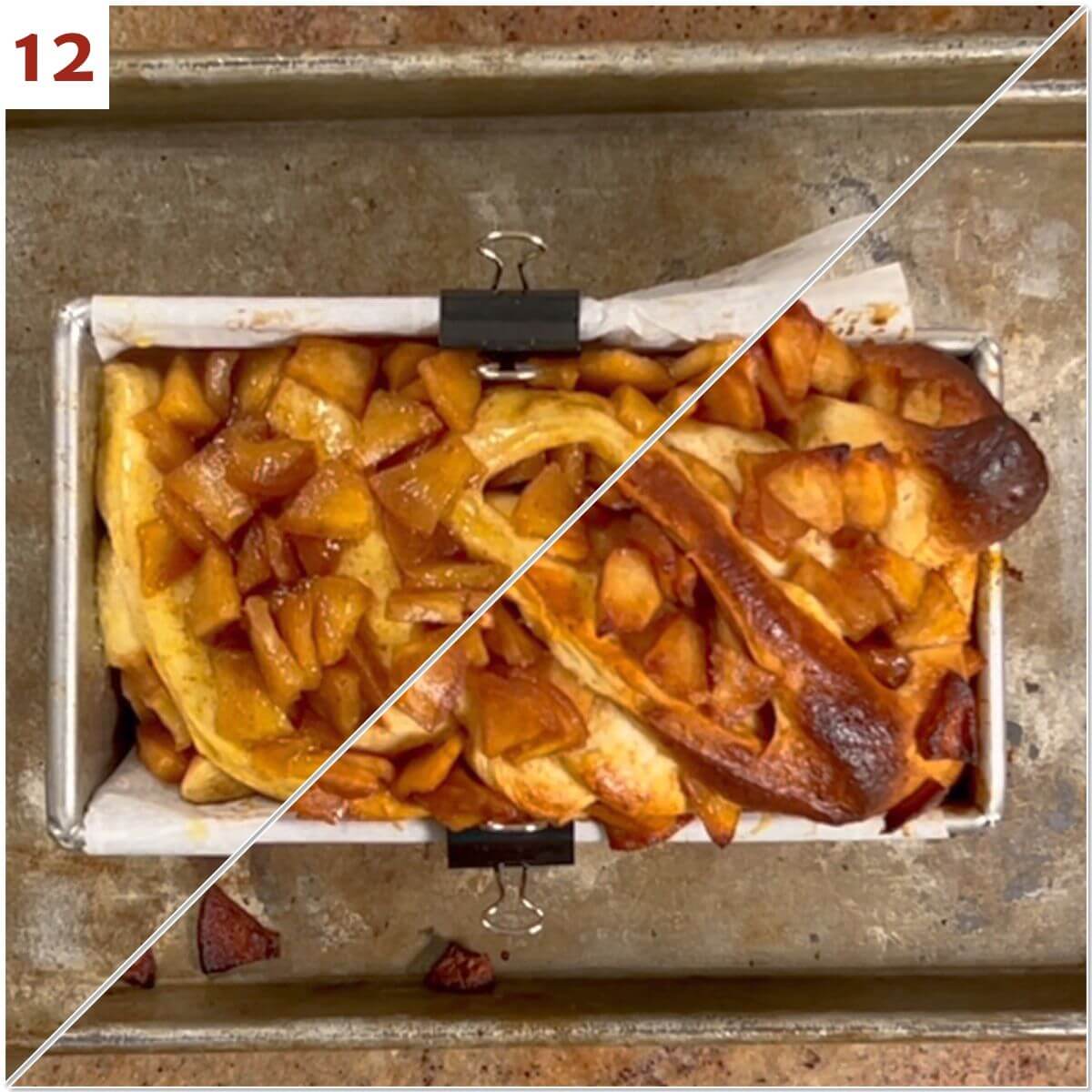
Step 5: Glaze the babka
In a medium bowl, whisk together the sifted powdered sugar and salt.
Add the boiled cider and 1 teaspoon of milk into the powdered sugar mixture and stir until the mixture is smooth (photo 13).
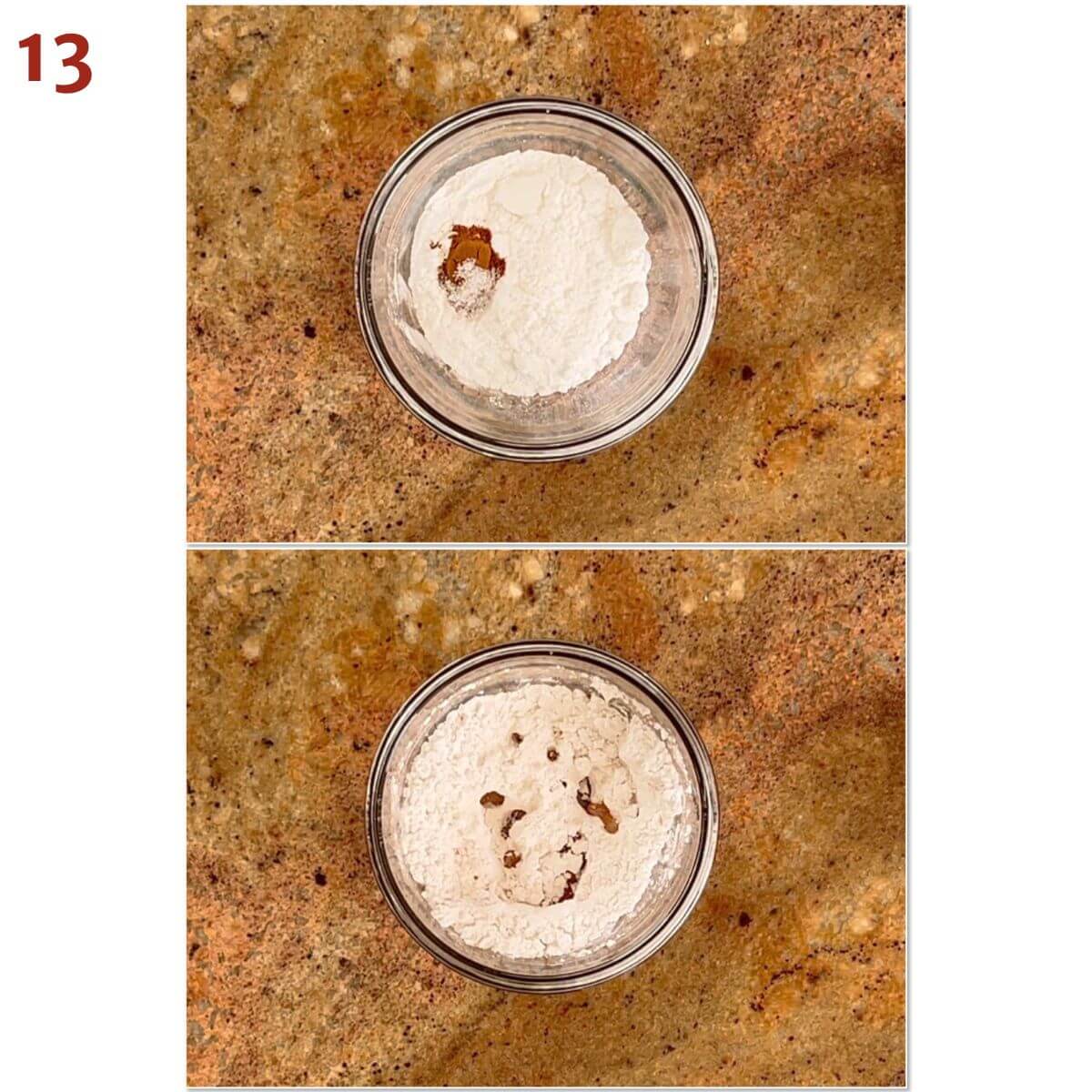
The mixture will be thick, but should still drizzle from a spoon (like the consistency of molasses). Adjust the glaze's consistency with additional milk (if it's too thick) or powdered sugar (if it's too thin) in ½ teaspoon increments as needed (photo 14).
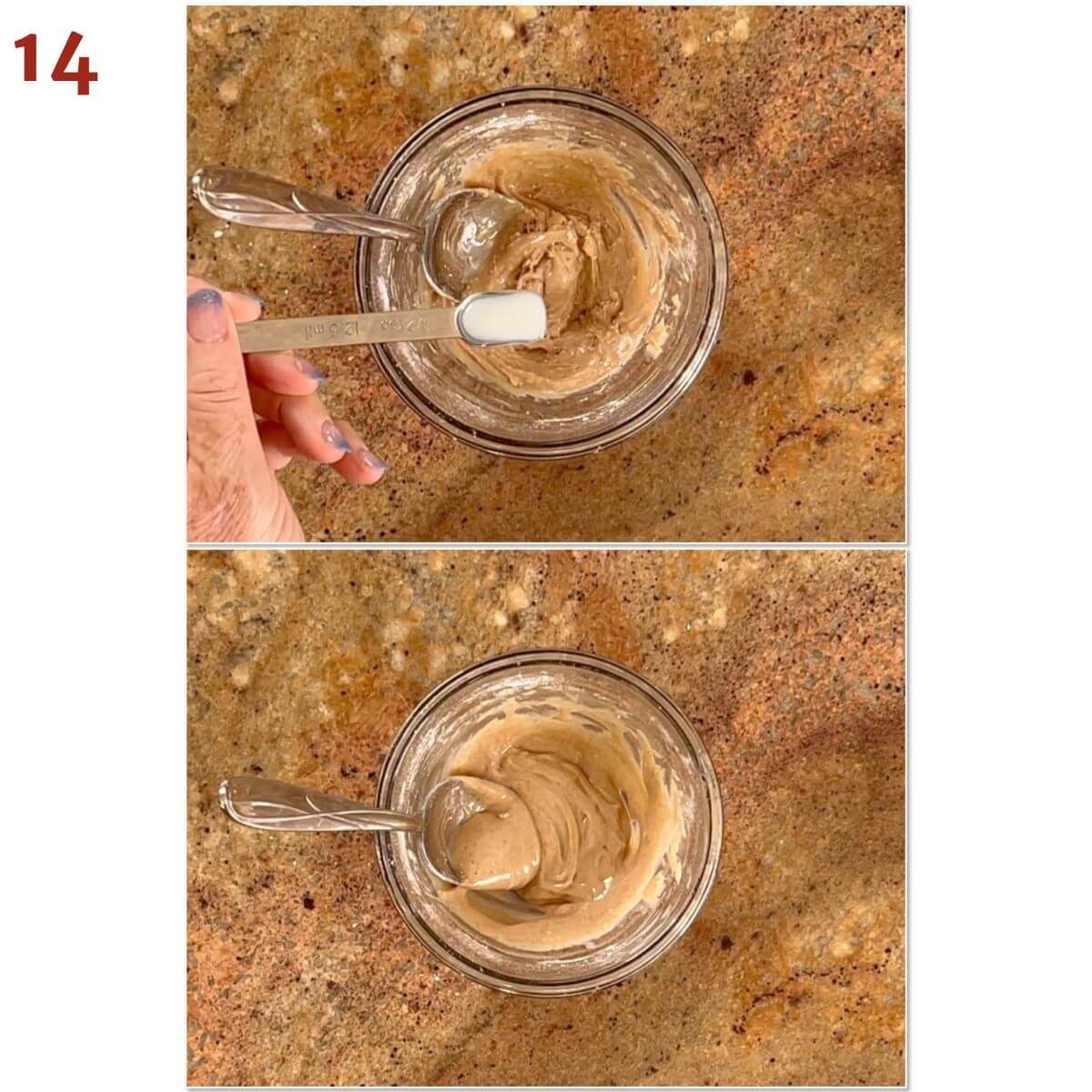
The glaze will resist drying at room temperature if it’s too loose, so it's best to drizzle a bit on a plate or wax paper and see if it sets after about 10 minutes or so (photo 15). If it doesn't dry, add in a little more powdered sugar to the icing.
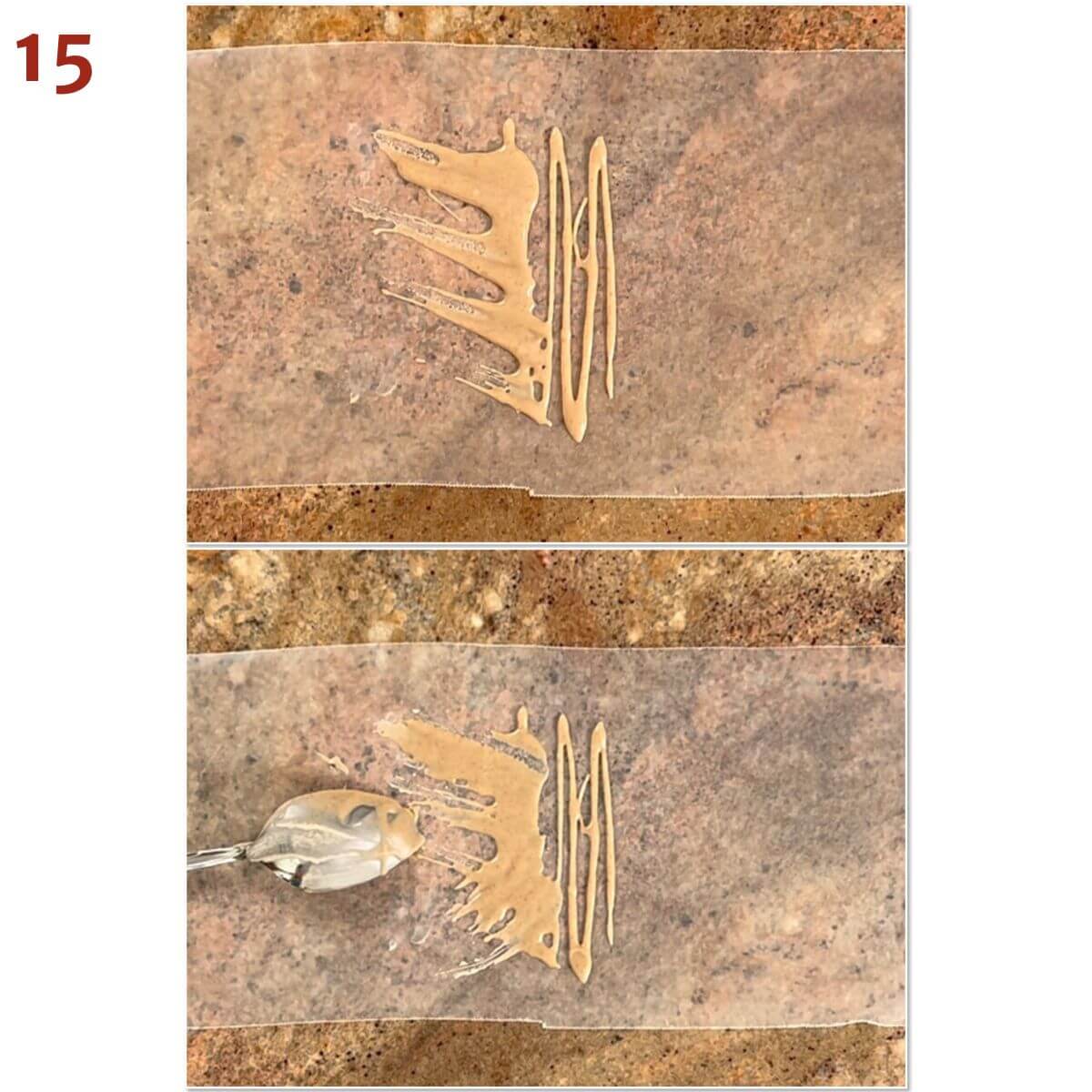
Place the glaze in a disposable pastry bag and snip a small opening at the bottom (or use a small ziplock bag and snip the corner). Drizzle the glaze over the babka, letting it set for about 10 minutes (photo 16).

Storage and make-ahead instructions
Storage instructions: The unglazed apple babka will keep well wrapped or in an airtight container for 3 to 4 days.
Make-ahead instructions: The filling and glaze can be made up to 5 days ahead, covered tightly and stored in the refrigerator. Bring them to room temperature before using.
Questions asked and answered
Here are some questions you might have...
Babka has its roots in the Eastern European Jewish community who brought it with them as they migrated to the New World.
At its core, babka is a brioche-like bread recipe that's spread with some sort of filling before being rolled up, cinnamon roll-style. Actually, it isn't far off from a basic challah recipe, just subbing in milk and butter for the water and oil. Given babka's origin story, that's not surprising because Jewish bakers bake challah for the weekly sabbath meal.
Not a lot! A brioche recipe contains more butter and milk and will be richer than babka. And while a babka recipe can contain butter and milk, it can also be made with canola oil and water, giving it a drier texture than brioche.
Because the babka is sweet, it's generally served warmed or at room temperature for breakfast, brunch, as an afternoon snack, or dessert. You can also slice it thickly and use it for french toast. Babka also is great in a baked french toast casserole!
Instant yeast doesn't need to be rehydrated (or "proved"), and can be added directly to the bread recipe's dry ingredients.
Active yeast needs to be rehydrated in a warm liquid before using (or have very warm liquid, between 120 to 130°F, in the recipe), and will take about 15 to 20 minutes longer to rise than instant yeast.
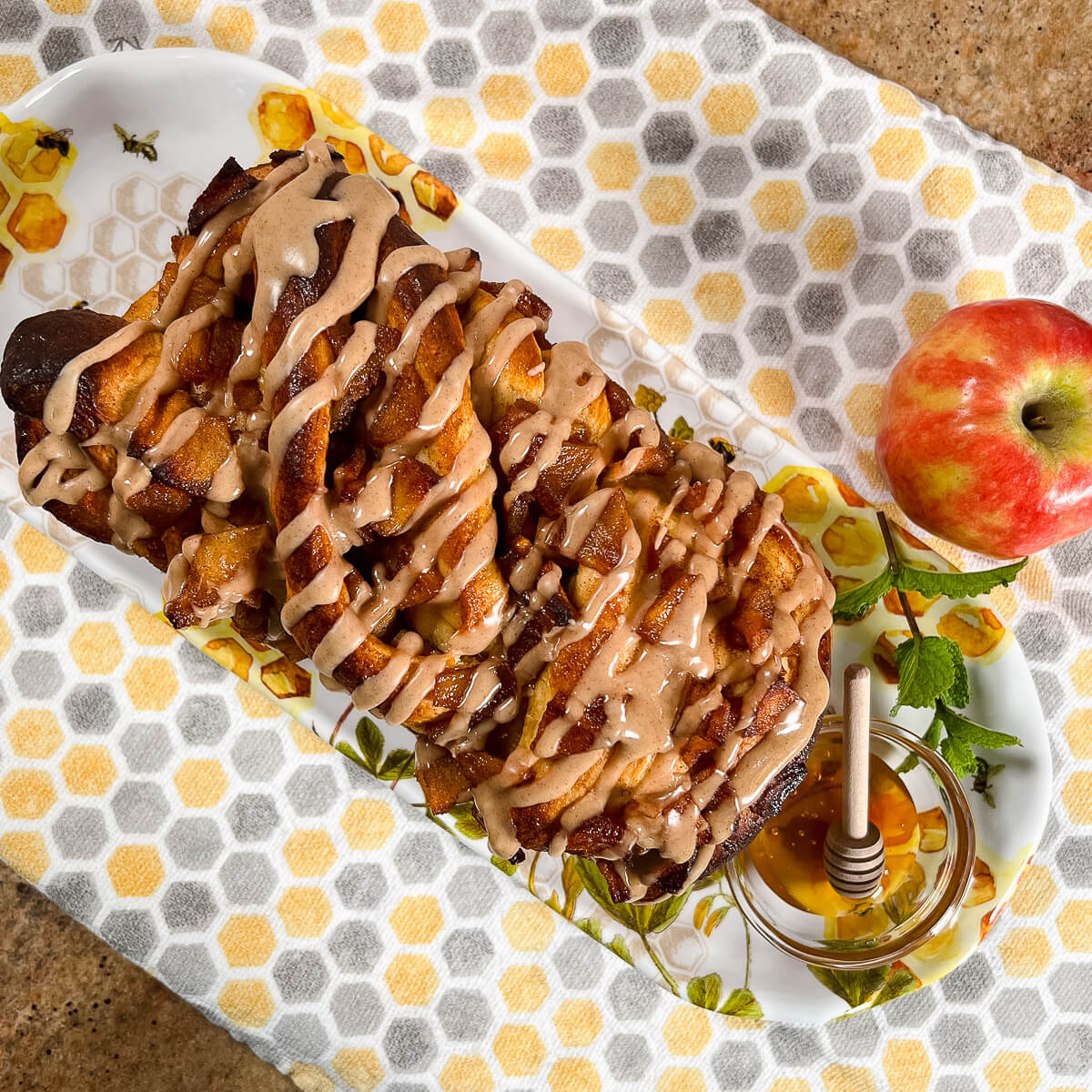
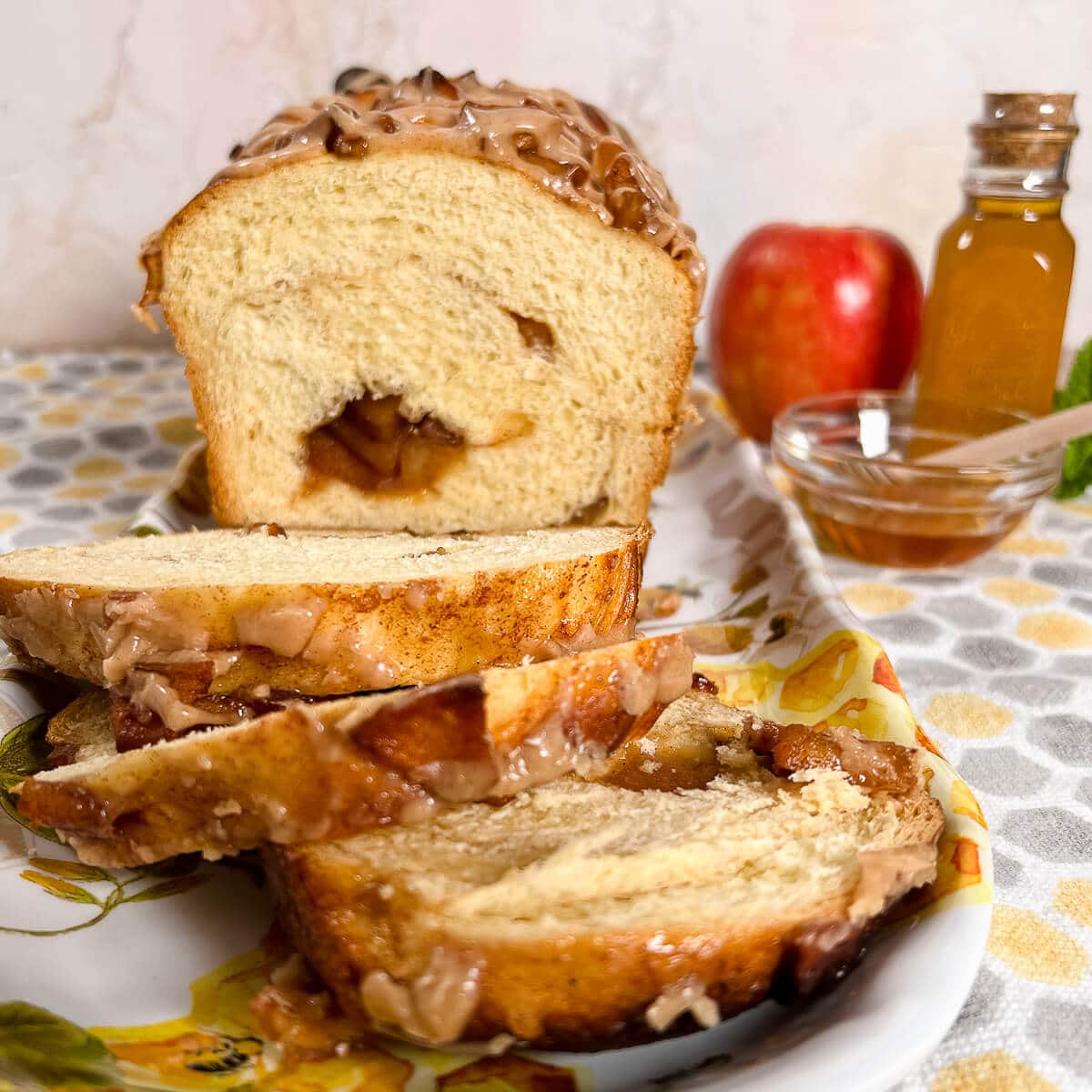
More shaped bread recipes to try
Recipe
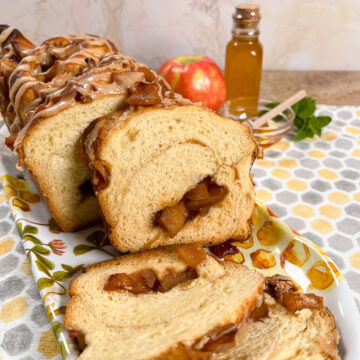
Apple Honey Babka
Equipment
Ingredients
For the dough
- ½ cup milk, warmed between 100°F to 110°F
- 1 teaspoon granulated sugar
- 1½ teaspoons instant yeast, or Active Dry yeast
- 1 large egg, at room temperature
- ¼ cup honey
- 1½ teaspoons pure vanilla extract
- 3 cups all-purpose flour
- ½ teaspoon kosher salt
- 3 tablespoons unsalted butter, softened
For the apple filling
- 3 cups apples, about 4 medium apples, see Recipe Notes
- 3 tablespoons unsalted butter
- ⅓ cup honey
- 2 tablespoons boiled apple cider, homemade or store bought
- 1 teaspoon ground cinnamon
For the egg wash
- 1 large egg, beaten
- 1 tablespoon water
For the apple glaze
- ½ cup powdered sugar, sifted, or more as needed
- ¼ teaspoon ground cinnamon
- pinch kosher salt
- 1½ teaspoons boiled apple cider, homemade or store bought, see Recipe Notes
- 1 to 1½ teaspoons milk
Instructions
- Prepare the dough: Heat the milk until it’s warm to the touch, about 100 °F to 110 °F as read on a digital thermometer. Stir in the sugar, then sprinkle the yeast over the milk and set aside to proof for about 5 minutes or until bubbles form on the surface of the milk.
- Pour the milk into the bowl of a stand mixer fitted with the paddle attachment. Add the egg, honey, and vanilla, then mix on low speed for about 30 seconds. Add the flour and the salt and mix on low speed until a sticky dough forms. Add the butter, 1 tablespoon at a time, and mix in thoroughly before adding in another tablespoon.
- When all the butter is incorporated, switch to the dough hook and knead the dough on medium speed until a smooth and slightly sticky dough forms, about 5 to 10 minutes. Add more flour in 1 tablespoon increments as needed to make the dough the right consistency. Gather the dough into a ball, stretching it so the top of the ball is smooth.
- Spray a 2-quart dough rising bucket or a large bowl with canola oil spray and place the dough ball in smooth side down to wipe it with oil. Turn the dough with the gathered rough part of the dough down and the smooth surface of the ball facing up. Cover with the lid or plastic wrap and let it rise in a warm place for about 1 hour, or until the dough has doubled in size. The inside of an unheated oven with the light on works well.
- Make the apple filling: Peel and core the apples, then slice the apples thinly, about ⅛-inch thick. See the Recipe Notes for tips on the best way to do this step. Cut the sliced apples into small pieces.
- Melt the butter in a large skillet over medium-high heat. Cook the apples, stirring occasionally, until they start to soften, about 5 to 10 minutes depending on the thickness of the slices.
- Add the honey, boiled apple cider, and cinnamon to the cooked apples. Reduce the heat and simmer until the sauce has thickened, about 8 to 10 minutes. Transfer to a bowl and allow the apples to cool to room temperature, about 30 minutes.
- Assemble the babka: Spray a standard loaf pan with baking spray and line with parchment paper, leaving a 2-inch overhand on the long sides. Set aside.
- Dust a clean surface with flour and roll the dough out to a rectangle roughly 10- x 14-inches, about ¼-inch thick, with a long side facing you (landscape orientation).
- Using a large offset spatula, spread the cooled apples over the surface of the dough, leaving a 1-inch strip bare along the long side away from you. Tightly roll the dough up from the long side facing you, making a 14-inch rope. Try to catch as much of the filling as possible as you roll so it will be evenly distributed in the babka.
- Slice the rope in half lengthwise using a bench scraper, making two 14-inch long pieces. If you want, you can twist each long piece individually so the apples are trapped inside the dough, tucking in any apples that may have fallen out.
- Wrap the two lengths of dough together into a rope. Squish the twisted dough together and transfer it to the prepared loaf pan, tucking in any stray pieces of apples and dough. This is messy business but worth it in the end!
- Cover the pan with a shower cap or a piece of greased plastic wrap and let the dough rest for 30 minutes.
- Bake the babka: While the babka loaf is resting, preheat the oven to 350 °F.
- Whisk together the beaten egg with the water to make an egg wash. Once the dough has rested (it won’t have risen much, just a tiny bit), brush the egg wash onto the top of the dough with a pastry brush.
- Place the loaf pan on a quarter sheet baking pan (to catch any drips) and bake for 45 minutes. Cover the top with foil after about 30 minutes if it's getting too dark.
- Reduce the oven temperature to 325 °F and continue to bake until the top of the babka is deep brown, about 15 minutes more, and the loaf sounds hollow when tapped on the top. The babka will be fully baked when the center reads at least 190 °F.
- Let babka cool in the pan for 15 minutes on a wire cooling rack, then use the parchment paper to lift the babka out of the pan and transfer it to back to the wire cooling rack. Let cool completely.
- Make the apple glaze: In a medium bowl, whisk together the powdered sugar, cinnamon, and salt.
- Add the boiled cider and 1 teaspoon of milk into the powdered sugar mixture and stir until smooth. The mixture will be thick, but should still drizzle from a spoon (like the consistency of molasses). Adjust the glaze's consistency with additional milk (if it's too thick) or powdered sugar (if it's too thin) in ½ teaspoon increments as needed.
- The glaze will resist drying at room temperature if it’s too loose, so it's best to drizzle a bit on a plate or wax paper and see if it sets after about 10 minutes or so. If it doesn't dry, add in a little more powdered sugar to the icing.
- Place the glaze in a disposable pastry bag and snip a small opening at the bottom (or use a small ziplock bag and snip the corner). Drizzle the glaze over the babka, letting it set for about 10 minutes. Serve & enjoy!
- Storage instructions: The unglazed babka will keep well wrapped or in an airtight container for 3 to 4 days. You an also slice it thickly and use it for Apple French Toast. Delicious!
- Make-ahead instructions: The filling and glaze can be made up to 5 days ahead, covered tightly and stored in the refrigerator. Bring them to room temperature before using.



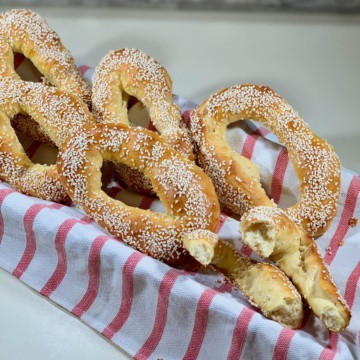



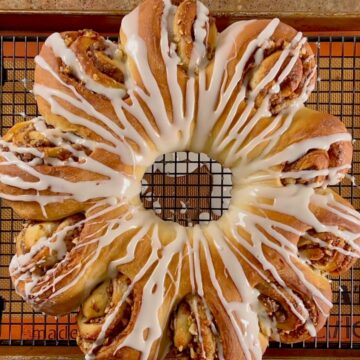



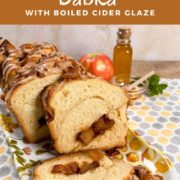
Let's Talk